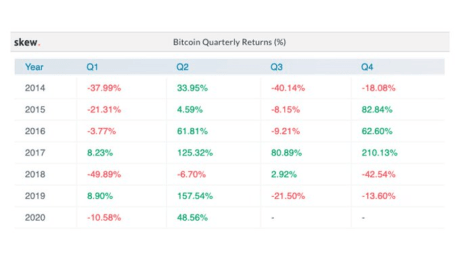Despite major volatility caused by the halving, Bitcoin has ended yet another Q2 in the green. After showing poor performance in Q1 being down 10% QoQ, Bitcoin closed the year’s second quarter with a price increase of 48.56 percent.
Bitcoin Finally Gets Out Q1 Rut
The economic downturn caused by the COVID-19 pandemic has left the crypto industry in shambles in the first three months of the year, losing over $74 billion in market cap in a single week.
The first quarter of the year was the third consecutive negative quarter Bitcoin has seen since 2015, ending it with a 10.58% loss when compared to the fourth quarter of 2019.
However, it seems that the volatility many predicted would cause an even worse performance in Q2 didn’t hit as hard, as Bitcoin closed the second quarter of the year with a significant gain.
According to data from cryptocurrency tracking and analysis company Skew, Bitcoin ended the quarter with a 48.58% gain compared to the previous quarter.
Historically, Bitcoin has had only one negative return in the second quarter of the year since 2014— in Q2 2018 which was a mere 6.7%.
The average return of investing in Bitcoin from 2014 in Q2 only is nearly 60% while the returns are abysmally low for Q3 at less than 1 %.

Table showing the quarterly returns for Bitcoin from 2014 to 2020. (Source: Skew)
Q2 Success Doesn’t Mean Bitcoin is Out of the Bear Phase
While Bitcoin’s price has, despite bouts of volatility, been growing in the past quarter, the world’s largest cryptocurrency still has a long way to go before it breaks through some major resistance levels that are still holding it in a bear market.
An attempt to break through the $10,000 barrier proved unsuccessful last week, when the closest Bitcoin got to the mark was the several hours it spent at $9,700.
As of press time, it seems that the world’s largest cryptocurrency has established solid support at $9,500. If the trend of massive jumps followed by a consolidation phase continues in the next few days, we might see Bitcoin establish support at a higher level.
However, the upward momentum might not last that long if Bitcoin continues to repeat its previous quarterly performance.
Historically, BTC has seen a poor performance in third quarters of the year, with the only positive return being in Q3 2017.
Featured Image from Shutterstock
















